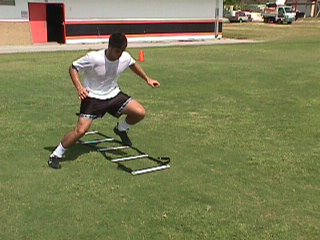In Season Training
Training in season is the dark hole of the athletic development process. It seems everyone is able to do a good job preparing when there is no competition but what happens when the competitive season starts? Typically the first few weeks go OK because there is inertia from the previous training, then the training tapers off to almost nothing. This is a huge mistake. The common excuse for this is that there is not enough time. Time is not an excuse. Remember training is cumulative. 10 to 15 minute blocks of training supplemented by an occasional 20 to 30 minute block will get the job done. This is assuming that that the preparation has been done before the competitive season started. 15 minutes a day for 5 days totals one hour and fifteen minutes. Multiply that out over a 28 or 32 week season and it is a significant investment of time. The secret is to have the time thoroughly planned so they correlate with the phase of competition and the individual’s needs. Remember everyone MUST warm-up so it all starts with a structured active warm-up for each training session. This emphasizes movement, not sitting on the ground and stretching. Each individual athlete should have a remedial program that they do on their own
 time. An example would be the stretch cord for hamstring injury prevention. (See picture of Jose Reyes, Shortstop for the METS doing a stretch cord hamstring exercise)
time. An example would be the stretch cord for hamstring injury prevention. (See picture of Jose Reyes, Shortstop for the METS doing a stretch cord hamstring exercise)  Strength training must be maintained during the season. Especially leg strength and total body strength. Even more important for the female athlete. Session do not have to be long but must be directed. Three or four exercises are sufficient. Use total body movement like a squat to a press, you get more bang for your buck. (see picture of Squat to Press) More on this in another blog.
Strength training must be maintained during the season. Especially leg strength and total body strength. Even more important for the female athlete. Session do not have to be long but must be directed. Three or four exercises are sufficient. Use total body movement like a squat to a press, you get more bang for your buck. (see picture of Squat to Press) More on this in another blog.
As far as overall fitness, the practices themselves should address a lot of this. In transition and intermittent sports it is necessary to do a little more. I refer to the work of Dr Billat from
Billat, Véronique L., Slawinski, Jean, Bocquet, Valery, Demarle, Alexandre., Lafitte, Laurent ., Chassaing, Patrick ., Koralsztein, Jean-Pierre. (2000) “Intermittent runs at the velocity associated with maximal oxygen uptake enables subjects to remain at maximal oxygen uptake for a longer time than intense but submaximal runs” European Journal of Applied Physiology Volume 81, Number 3 January Pages: 188 – 196
Billat , V. L., Slawinksi, J., Bocquet, V., Chassaing, P., Demarle, A., Koralsztein, J. P. (2001) Very Short (15 s - 15 s) “Interval-Training Around the Critical Velocity Allows Middle-Aged Runners to Maintain V˙O2 max for 14 minutes” Int J Sports Med Vol 22: 201-208
These articles will be helpful to you.
 Speed and agility must be trained, once again in short bursts. I put some footwork drills everyday and even sometimes on game day. I have found that the tune up the central nervous system.
Speed and agility must be trained, once again in short bursts. I put some footwork drills everyday and even sometimes on game day. I have found that the tune up the central nervous system.
Plan and attack this important phase of training to make your athletes better.


0 Comments:
Post a Comment
<< Home